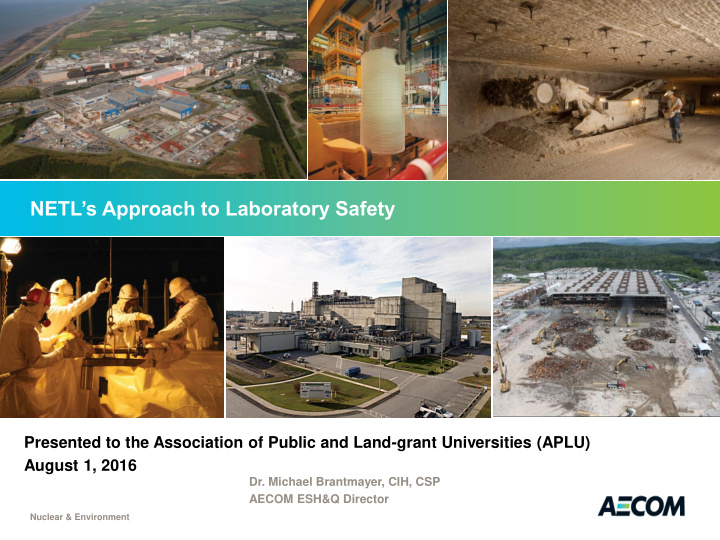



NETL’s Approach to Laboratory Safety Presented to the Association of Public and Land-grant Universities (APLU) August 1, 2016 Dr. Michael Brantmayer, CIH, CSP AECOM ESH&Q Director Nuclear & Environment
The NETL Environment • Government Owned & Operated DOE National Lab • Multi-purpose Facilities – Offices, research spaces • Multi-employer workplace – Federal, contractor, ORISE, university students, visitors, foreign nationals • Performing research while controlling risk – Achieving results while maintaining an incident/injury free workplace Page 2 AECOM Proprietary Data
NETL’s Approach to Safety • NETL’s safety program is certified to the ISO 14001 and OHSAS 18001 standards • Integrated Safety Management – – Approach to planning and managing work • integrates safety throughout the work flow process • recognizes line management as accountable for safety • Safety Analysis and Review System (SARS) – A hazard analysis and mitigation system • Training – Employees receive comprehensive safety training before working in the labs – Completion centrally tracked through in-house system (STeMS) Page 3 AECOM Proprietary Data
Approach to Safety in the Labs NETL fosters a culture of safety primarily through a two-pronged approach: 1. Professional engineering services for research system design, maintenance, and management of change 2. Safety Analysis and Review System (SARS) for R&D operations. Page 4 AECOM Proprietary Data
R&D SARS Hazard Analysis and Mitigation system – No work is performed without a safety review. – Every project reviewed and explicitly permitted. – Graded approach to safety and hazard control. – Risks are identified and mitigated to a level acceptable to management. – Activity Hazard Analysis (AHA) program fills gaps for small tasks not covered under R&D SARS. – Field Work has its own AHA to identify and control hazards for activities away from the lab. – Research is dynamic, and NETL’s program recognizes and addresses change through memos to file or R&D SARS modification. – Permits issued under R&D SARS are re-assessed annually to verify that hazard mitigations are still effective. Page 5 AECOM Proprietary Data
Success is Measured • Success is measured through the number safety incidents and our response to them. • We track: – OSHA Recordable Incident Rate • Currently <0.58 injuries per 100 employees • Our goal is zero – OSHA DART Rate (Lost Time) • Currently 0.0 – Hours worked without a lost-time injury • Currently over 1.8 million hours Page 6 AECOM Proprietary Data
Incidents are Investigated • Incidents, injuries and near misses are vigorously investigated. – Root Cause Analysis is performed where appropriate to identify the causes so they can be corrected. – Lessons Learned publications are developed shared with the workforce and worked into hazard analyses and training to promote a safe environment and allow us to learn from our mistakes. Page 7 AECOM Proprietary Data
Support and Buy-in are a Necessity • Leadership at all levels must support and drive the program. • Researchers must buy-in and actively participate. • Credibility is earned through reasonable, timely, realistic approaches to risk assessment and mitigation. Page 8 AECOM Proprietary Data
Summary • NETL’s safety program is driven through the DOE Integrated Safety Management System. • Hazard analysis and mitigation is accomplished through R&D SARS and is required for all projects. • Employee involvement is essential for success. • The goal is safe employees and safe research Page 9 AECOM Proprietary Data
Contact Information Dr. Michael Brantmayer, CIH, CSP AECOM ESH&Q Director (304) 285 – 4194 Michael.Brantmayer@netl.doe.gov Page 10 AECOM Proprietary Data
Recommend
More recommend